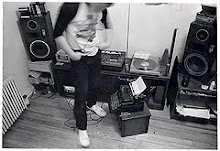I took it out of the case and looked it over. The decoration was really nice, and the workmanship seemed good. The case was solid and I ran my fingers through the plush lining. When I flipped open the storage compartment I recognized that I'd stumbled into private territory. I found some seeds, tiny bits of weed and one of those tiny ziplock bags - no doubt the remnants of my neighbor's teenage stash.
What was garbage a moment earlier suddenly became invested with meaning; this guitar part of someone's life, an emotional piece of this guy's coming of age. I could imagine him jamming with his buddies and the good times he must have associated with the guitar. I understood why he might have been hesitant to let me take it. I doubt he remembered what was tucked deep inside, but no doubt he wanted to move on, and I bet it took some doing to let the guitar go.
 The guitar is a Cortley copy of a Gibson Dove, and it looks like the actual Gibson that Elvis is playing in the picture. I even found a website dedicated to the copy guitar! People said nice things about it online, and I was inspired to fix it. I got me some Gorilla Glue and a clamp, did as good a job as I could gluing it back together. A bit cruder of a repair than I'd hoped. But when I strung the guitar up, it held.
The guitar is a Cortley copy of a Gibson Dove, and it looks like the actual Gibson that Elvis is playing in the picture. I even found a website dedicated to the copy guitar! People said nice things about it online, and I was inspired to fix it. I got me some Gorilla Glue and a clamp, did as good a job as I could gluing it back together. A bit cruder of a repair than I'd hoped. But when I strung the guitar up, it held.And when I tuned it up and began to play, the guitar sounded with a warmth that made me smile.



